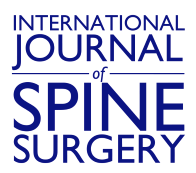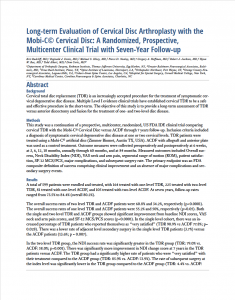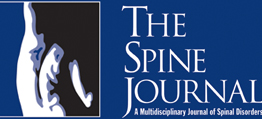
Abstract
BACKGROUND: Cervical total disc replacement (TDR) is an increasingly accepted procedure for the treatment of symptomatic cervical degenerative disc disease. Multiple Level I evidence clinical trials have established cervical TDR to be a safe and effective procedure in the short-term. The objective of this study is to provide a long-term assessment of TDR versus anterior discectomy and fusion for the treatment of one- and two-level disc disease.
METHODS: This study was a continuation of a prospective, multicenter, randomized, US FDA IDE clinical trial comparing cervical TDR with the Mobi-C© Cervical Disc versus ACDF through 7 years follow-up. Inclusion criteria included a diagnosis of symptomatic cervical degenerative disc disease at one or two cervical levels. TDR patients were treated using a Mobi-C© artificial disc (Zimmer Biomet, Austin TX, USA). ACDF with allograft and anterior plate was used as a control treatment. Outcome measures were collected preoperatively and postoperatively at 6 weeks, at 3, 6, 12, 18 months, annually through 60 months, and at 84 months. Measured outcomes included Overall success, Neck Disability Index (NDI), VAS neck and arm pain, segmental range of motion (ROM), patient satisfaction, SF-12 MCS/PCS, major complications, and subsequent surgery rate. The primary endpoint was an FDA composite definition of success comprising clinical improvement and an absence of major complications and secondary surgery events.
RESULTS: A total of 599 patients were enrolled and treated, with 164 treated with one-level TDR, 225 treated with two-level TDR, 81 treated with one-level ACDF, and 105 treated with two-level ACDF. At seven years, follow-up rates ranged from 73.5% to 84.4% (overall 80.2%).The overall success rates of two level TDR and ACDF patients were 60.8% and 34.2%, respectively (p<0.0001). The overall success rates of one level TDR and ACDF patients were 55.2% and 50%, respectively (p>0.05). Both the single and two level TDR and ACDF groups showed significant improvement from baseline NDI scores, VAS neck and arm pain scores, and SF-12 MCS/PCS scores (p<0.0001). In the single level cohort, there was an increased percentage of TDR patients who reported themselves as “very satisfied” (TDR 90.9% vs ACDF 77.8%; p= 0.028). There was a lower rate of adjacent level secondary surgery in the single level TDR patients (3.7%) versus the ACDF patients (13.6%; p = 0.007).In the two level TDR group, the NDI success rate was significantly greater in the TDR group (TDR: 79.0% vs. ACDF: 58.0%; p=0.001). There was significantly more improvement in NDI change score at 7 years in the TDR patients versus ACDF. The TDR group had a significantly higher rate of patients who were “very satisfied” with their treatment compared to the ACDF group (TDR: 85.9% vs. ACDF: 73.9%). The rate of subsequent surgery at the index level was significantly lower in the TDR group compared to the ACDF group (TDR: 4.4% vs. ACDF: 16.2%; p=0.001). The rate of adjacent level secondary surgery was significantly lower in the two level TDR (4.4%) patients compared to the ACDF (11.3%; p=0.03) patients. In both single and two level cohorts, the percentage of patients with worse NDI (2.5%-3.8% of two level surgeries and 1.2%-2.5% of single level surgeries) or worse neck pain (5%-6.8% of the two level surgeries and 1.3% – 3.8% of the single level surgeries) was strikingly low in both groups but trended lower in the TDR patients.
CONCLUSIONS: At seven years, the composite success analysis demonstrated clinical superiority of two level TDR over ACDF and non-inferiority of single level TDR versus ACDF. There were lower rates of secondary surgery and higher adjacent level disc survivorship in both groups. Both surgeries were remarkably effective in alleviating pain relative to baseline and the rate of patients with worse disability or neck pain was surprisingly low. Overall, greater than 95% of patients (from both groups) who underwent TDR and 88% of patients who underwent ACDF were “very satisfied” at seven years. The differences in clinical effectiveness of TDR versus ACDF becomes more apparent as treatment increases from one to two levels, indicating a significant benefit for TDR over ACDF for two-level procedures.
To Read The Full Article Click Here
PMID:29372135 PMCID:PMC5779239 DOI:10.14444/4031





